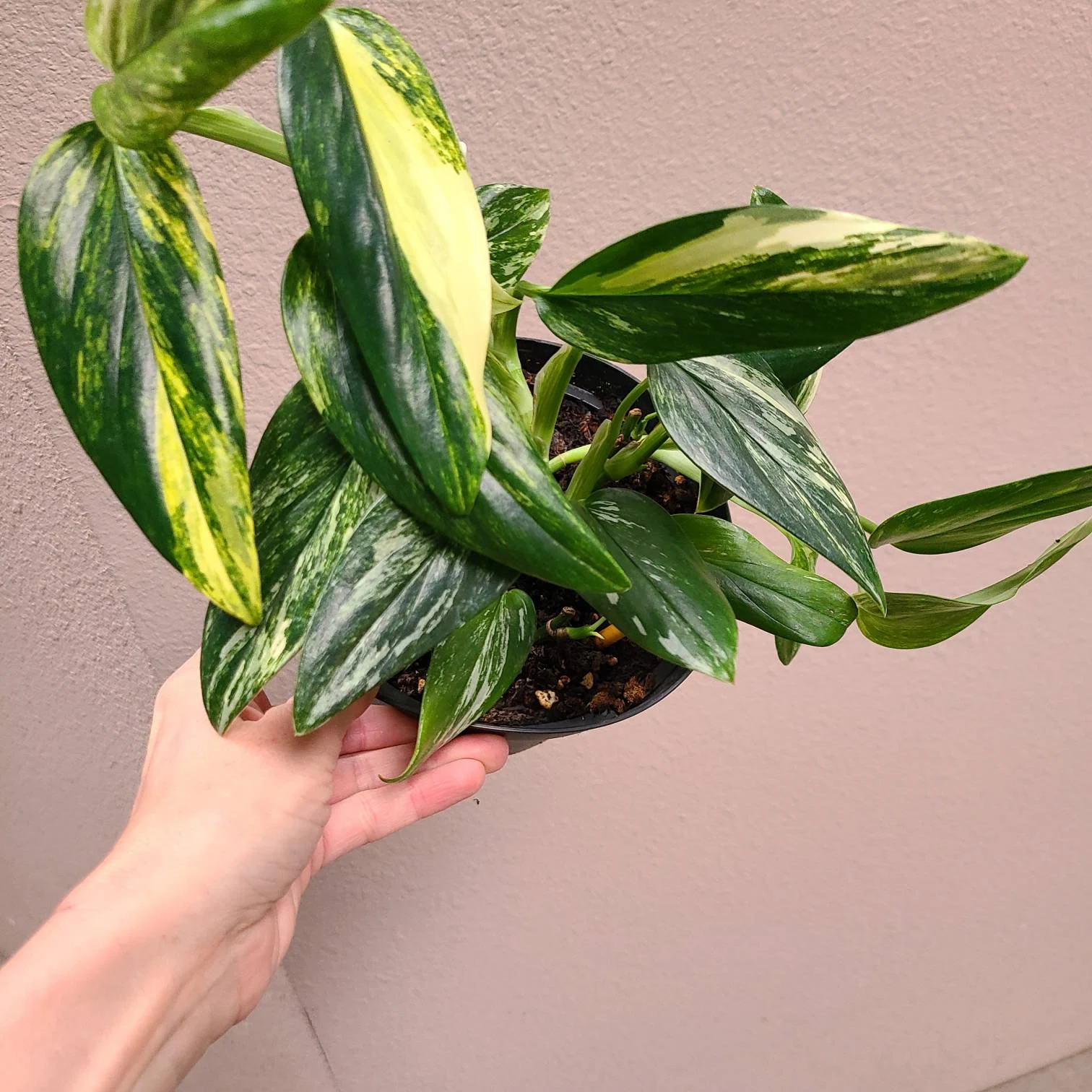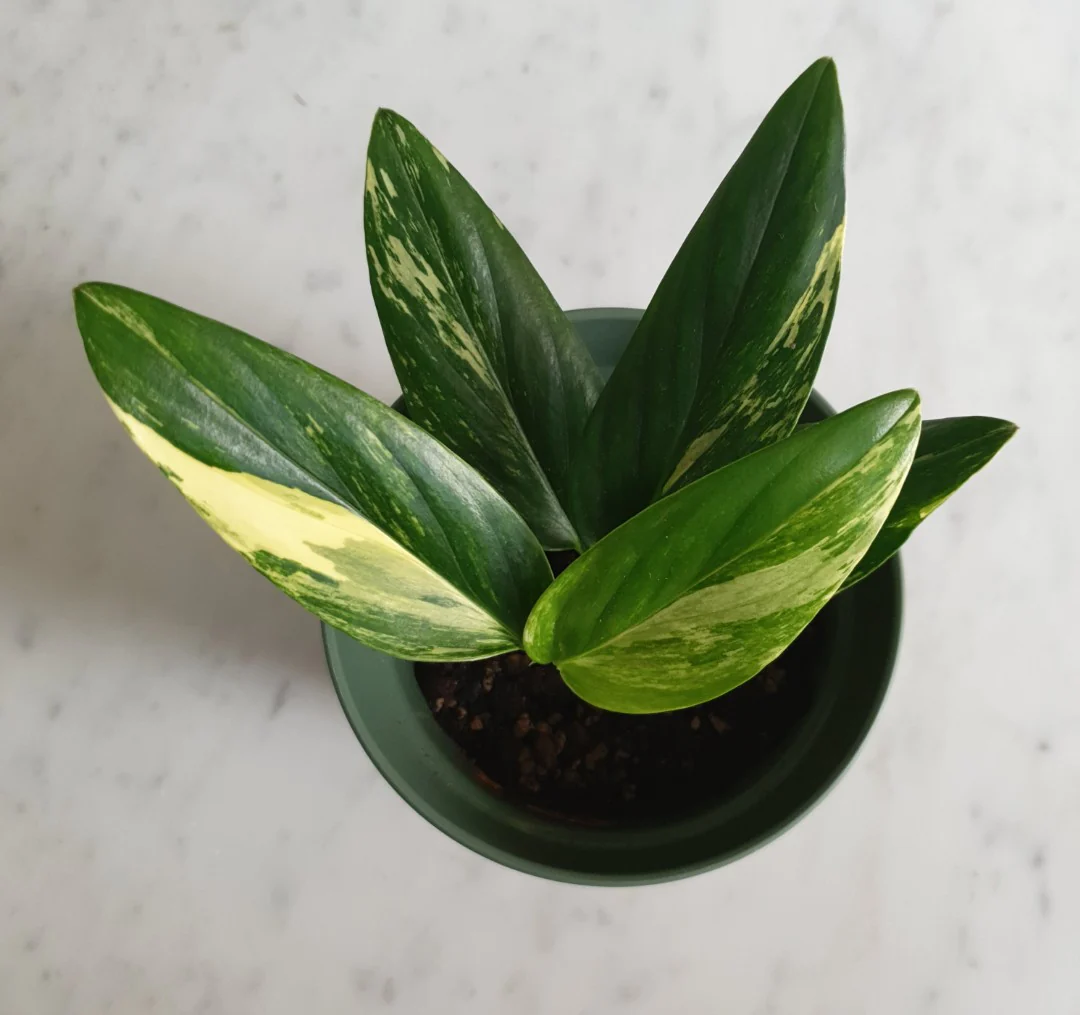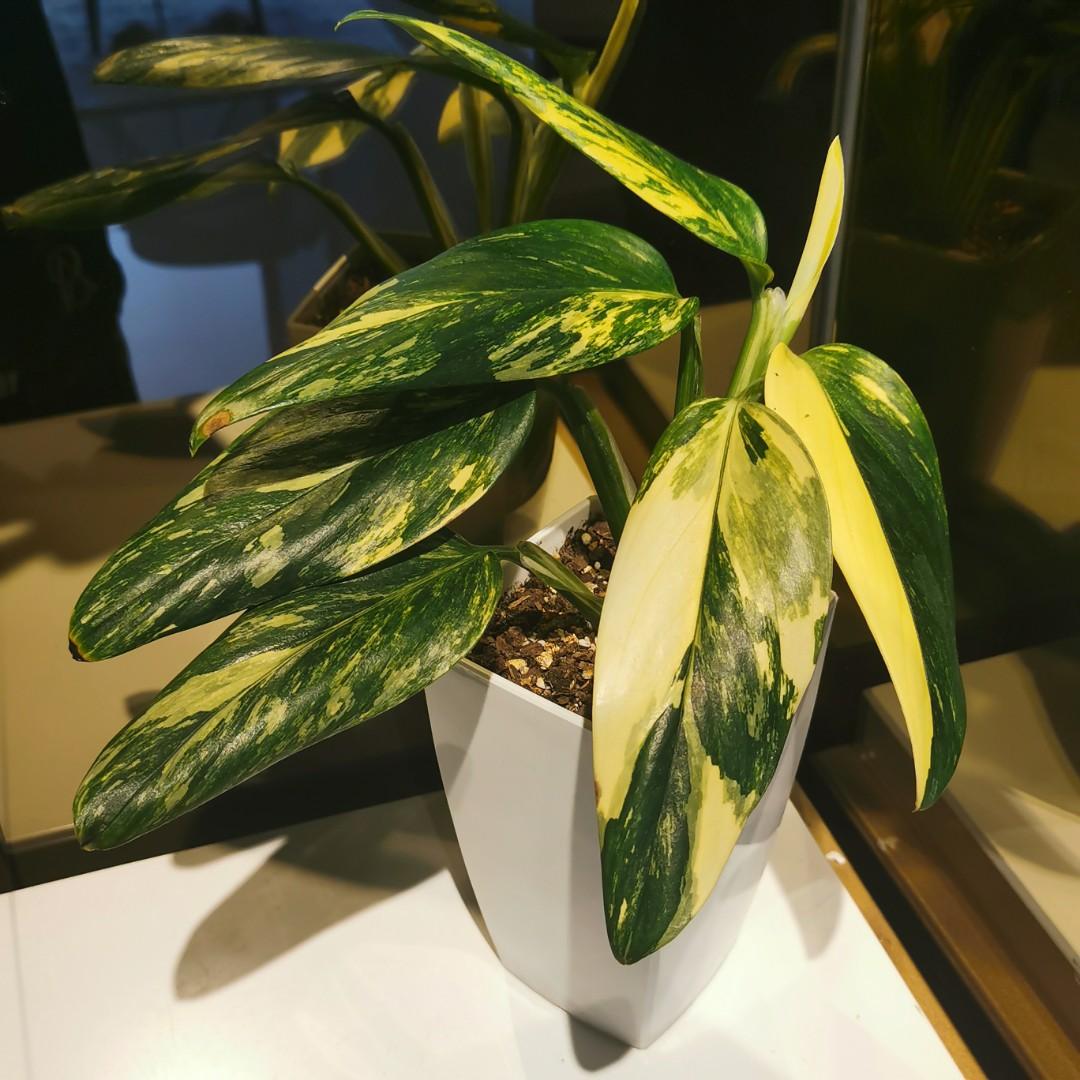Monstera Standleyana Variegated: A Guide to Care and Propagation
The Monstera standleyana variegata, also known as the Variegated Monstera or Variegated Swiss Cheese Plant, is a beautiful and unique tropical plant gaining popularity among houseplant enthusiasts. This variegated Monstera features stunning creamy-white or yellow variegation on its leaves, adding dimension and visual interest.

The Monstera standleyana variegata has distinct characteristics that set it apart from the regular Monstera varieties.
Foliage
The most striking feature of this plant is its variegated leaves. Unlike the solid green leaves of regular Monsteras, this variety has leaves with sections of white or pale yellow variegation. The variegated sections often occur along the veins or edges leaves. No two leaves seem to have the exact same variegation pattern, making each plant truly unique. The variegated leaves are a distinctive characteristic that sets the Monstera standleyana variegata apart, similar to other unique varieties described in our 'Types of Monstera' document.
Size
The Monstera standleyana variegata grows as an epiphytic vine in its native Central American habitat. With proper care and support, indoors plants can reach up to 3-4 feet in height. The leaves grow from 2-5 inches long and almost as wide.
Stems
Like other Monsteras, the stems have visible aerial roots that cling and climb onto trees and other surfaces as support. Indoors, these aerial roots can attach to a moss pole, giving the plant a tree-like form.

The Monstera standleyana variegata makes an exceptional, eye-catching houseplant and a prized addition to any plant parent's collection for several reasons:
Unique Appearance
The gorgeous and one-of-a-kind variegated foliage is probably the number one reason this plant is so sought-after. The beautiful contrast of white/yellow against the green adds dimension and visual allure.
Lower Maintenance Needs
Despite its tropical origins, this plant is relatively easy to maintain indoors. It tolerates a range of light and watering conditions. Once acclimatized, it's quite resilient to common issues. Despite its tropical origins, this plant is relatively easy to maintain, much like the general care tips outlined in our Monstera care guide.
Display Potential
A mature, supported Monstera standleyana variegata makes a true showstopper plant that instantly becomes the focal point wherever it is displayed. The large, low-maintenance tropical foliage offers huge decor potential.
Caring for the coveted Monstera standleyana variegata may seem daunting, but it simply comes down to addressing a few key needs:
Light
This plant thrives best in bright, indirect sunlight. A spot near a west or east facing window works nicely. Some direct sun is okay, but too much can scorch the leaves.
Water
Water when the top inch of soil is dry. Allow the soil to fully dry out between waterings to prevent issues with rot due to overwatering. As a tropical vine, it prefers slightly moist (but not wet) soil.
Humidity
Average room humidity is often adequate, but higher humidity supports best growth. Place plant on a pebble tray, mist leaves, or use a humidifier during dry winters.
Soil
A chunky, well-draining soil mix is vital to prevent overwatering. Use a quality potting mix amended with perlite, orchid bark, coconut coir.
Fertilizer
Fertilize monthly during active growth with a balanced, diluted liquid fertilizer. Reduce feeding in winter when growth slows.

Being aware of potential issues can help quickly resolve them before they become serious threats:
Insufficient Light
Leaves losing variegation and becoming greener likely indicates inadequate light. Gradually move plant to a brighter location for leaf variegation to return.
Overwatering
Excess moisture leads to rotting roots and stems. Allow soil to partially dry out between waterings and use a very well-draining mix. Remove affected parts immediately and adjust watering habits.
Pests
Spider mites, mealybugs and scale insects may sometimes infest leaves. Apply insecticidal soap, neem oil or other organic treatment to rid plant of pests. Isolate infected plants to prevent spreading.
The gloriously variegated Monstera standleyana variegata certainly lives up to the hype surrounding it! This rare tropical beauty remains highly coveted thanks to its showstopping foliage and easier care requirements. Following the basic care guidelines for providing adequate warm temperatures, moisture, humidity, and nutrients allows this plant to gracefully climb and put out its distinctive leaves. Pay close attention to proper irrigation, drainage, and pest prevention. With the right care, the Monstera standleyana variegata makes an unrivaled display plant sure to be the highlight of any plant collection or indoor space it inhabits. Ready to elevate your plant collection with this exotic beauty? Grab your own Monstera standleyana variegata here!
Is the Monstera standleyana variegata rare?
Yes, the natural variegated form is considered quite rare compared to the regular green varieties which are much more common. This contributes to high demand.
How do you propagate Monstera standleyana variegata?
Take stem tip cuttings with a node/aerial root, dip in rooting hormone, plant in sterile media and enclose in a clear plastic bag to root. Maintaining variegation in progeny plants is challenging. To learn more about propagating this variety, check out our comprehensive guide on Monstera propagation techniques.
Why are some leaves less variegated?
Insufficient light exposure often causes more solid green leaves. Moving plant to a brighter location should help improve variegation in new leaves.
What causes yellowing leaves?
Overwatering and soggy soils lead to root rot, which subsequently causes foliage yellowing. Allow soil to partly dry out between waterings and use a very well-draining mix to prevent issues.
https://bit.ly/3vkaSkt

Characteristics
The Monstera standleyana variegata has distinct characteristics that set it apart from the regular Monstera varieties.
Foliage
The most striking feature of this plant is its variegated leaves. Unlike the solid green leaves of regular Monsteras, this variety has leaves with sections of white or pale yellow variegation. The variegated sections often occur along the veins or edges leaves. No two leaves seem to have the exact same variegation pattern, making each plant truly unique. The variegated leaves are a distinctive characteristic that sets the Monstera standleyana variegata apart, similar to other unique varieties described in our 'Types of Monstera' document.
Size
The Monstera standleyana variegata grows as an epiphytic vine in its native Central American habitat. With proper care and support, indoors plants can reach up to 3-4 feet in height. The leaves grow from 2-5 inches long and almost as wide.
Stems
Like other Monsteras, the stems have visible aerial roots that cling and climb onto trees and other surfaces as support. Indoors, these aerial roots can attach to a moss pole, giving the plant a tree-like form.

Why Choose Monstera Standleyana Variegata
The Monstera standleyana variegata makes an exceptional, eye-catching houseplant and a prized addition to any plant parent's collection for several reasons:
Unique Appearance
The gorgeous and one-of-a-kind variegated foliage is probably the number one reason this plant is so sought-after. The beautiful contrast of white/yellow against the green adds dimension and visual allure.
Lower Maintenance Needs
Despite its tropical origins, this plant is relatively easy to maintain indoors. It tolerates a range of light and watering conditions. Once acclimatized, it's quite resilient to common issues. Despite its tropical origins, this plant is relatively easy to maintain, much like the general care tips outlined in our Monstera care guide.
Display Potential
A mature, supported Monstera standleyana variegata makes a true showstopper plant that instantly becomes the focal point wherever it is displayed. The large, low-maintenance tropical foliage offers huge decor potential.
Caring For Monstera Standleyana Variegata
Caring for the coveted Monstera standleyana variegata may seem daunting, but it simply comes down to addressing a few key needs:
Light
This plant thrives best in bright, indirect sunlight. A spot near a west or east facing window works nicely. Some direct sun is okay, but too much can scorch the leaves.
Water
Water when the top inch of soil is dry. Allow the soil to fully dry out between waterings to prevent issues with rot due to overwatering. As a tropical vine, it prefers slightly moist (but not wet) soil.
Humidity
Average room humidity is often adequate, but higher humidity supports best growth. Place plant on a pebble tray, mist leaves, or use a humidifier during dry winters.
Soil
A chunky, well-draining soil mix is vital to prevent overwatering. Use a quality potting mix amended with perlite, orchid bark, coconut coir.
Fertilizer
Fertilize monthly during active growth with a balanced, diluted liquid fertilizer. Reduce feeding in winter when growth slows.

Common Issues and Solutions
Being aware of potential issues can help quickly resolve them before they become serious threats:
Insufficient Light
Leaves losing variegation and becoming greener likely indicates inadequate light. Gradually move plant to a brighter location for leaf variegation to return.
Overwatering
Excess moisture leads to rotting roots and stems. Allow soil to partially dry out between waterings and use a very well-draining mix. Remove affected parts immediately and adjust watering habits.
Pests
Spider mites, mealybugs and scale insects may sometimes infest leaves. Apply insecticidal soap, neem oil or other organic treatment to rid plant of pests. Isolate infected plants to prevent spreading.
Conclusion
The gloriously variegated Monstera standleyana variegata certainly lives up to the hype surrounding it! This rare tropical beauty remains highly coveted thanks to its showstopping foliage and easier care requirements. Following the basic care guidelines for providing adequate warm temperatures, moisture, humidity, and nutrients allows this plant to gracefully climb and put out its distinctive leaves. Pay close attention to proper irrigation, drainage, and pest prevention. With the right care, the Monstera standleyana variegata makes an unrivaled display plant sure to be the highlight of any plant collection or indoor space it inhabits. Ready to elevate your plant collection with this exotic beauty? Grab your own Monstera standleyana variegata here!
FAQs
Is the Monstera standleyana variegata rare?
Yes, the natural variegated form is considered quite rare compared to the regular green varieties which are much more common. This contributes to high demand.
How do you propagate Monstera standleyana variegata?
Take stem tip cuttings with a node/aerial root, dip in rooting hormone, plant in sterile media and enclose in a clear plastic bag to root. Maintaining variegation in progeny plants is challenging. To learn more about propagating this variety, check out our comprehensive guide on Monstera propagation techniques.
Why are some leaves less variegated?
Insufficient light exposure often causes more solid green leaves. Moving plant to a brighter location should help improve variegation in new leaves.
What causes yellowing leaves?
Overwatering and soggy soils lead to root rot, which subsequently causes foliage yellowing. Allow soil to partly dry out between waterings and use a very well-draining mix to prevent issues.
https://bit.ly/3vkaSkt
Nhận xét
Đăng nhận xét